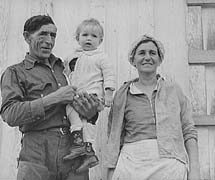
A Spanish muskrat trapper, his wife,
and their adopted child, Delacroix Island, Saint Bernard Parish,
Louisiana, 1941. The picture was taken by Marion Wolcott, a documentary
photographer who contributed to a new genre of government-created
images that were designed to mobilize public concern about social
problems, including poverty and child welfare.

This photograph of “children
from many races,” taken during a U.S.
Children's Bureau conference in Hawaii in the 1920s, suggests
that child welfare was a concept capable of drawing government
attention and resources to people of diverse ethnic and racial
backgrounds.
|
The modern belief that children
are innocent and vulnerable human beings with special needs for
care and protection during critical stages of physical and psychological
development is the premise of child welfare. Ordinarily, parents
are charged with providing care and protection to children, but
when they do not or cannot, the responsibility for insuring child
welfare rests with society at large. Child welfare as a collective,
social obligation is the rationale behind modern adoption regulation.
Since 1851 and the passage of the Massachusetts
Adoption of Children Act, laws have promoted the idea that adoption
is a process that should benefit children rather than meet adult
needs. In contrast to ancient and premodern adoptions, which were
often arranged to secure heirs for childless individuals or workers
for households, the ideology of child welfare promises that adoption
will offer children permanent love and belonging.
One summary of legal philosophy and reform in 1935 put it this
way: “The modern adoption legislation reflects a growing emphasis
on the necessity of a better understanding of the child’s individual
needs, so that he may be adopted into a home where he will be happy
and develop properly.” For advocates of adoption reform, child
welfare meant the elevation of “human” values over such
material considerations as labor and property. This was progress.

The single most important strategy for insuring
child welfare was educating actual and potential mothers. This photograph
depicts a “little mothers' class” during which high
school students in the early 1920s received instruction in infant
care.
|



